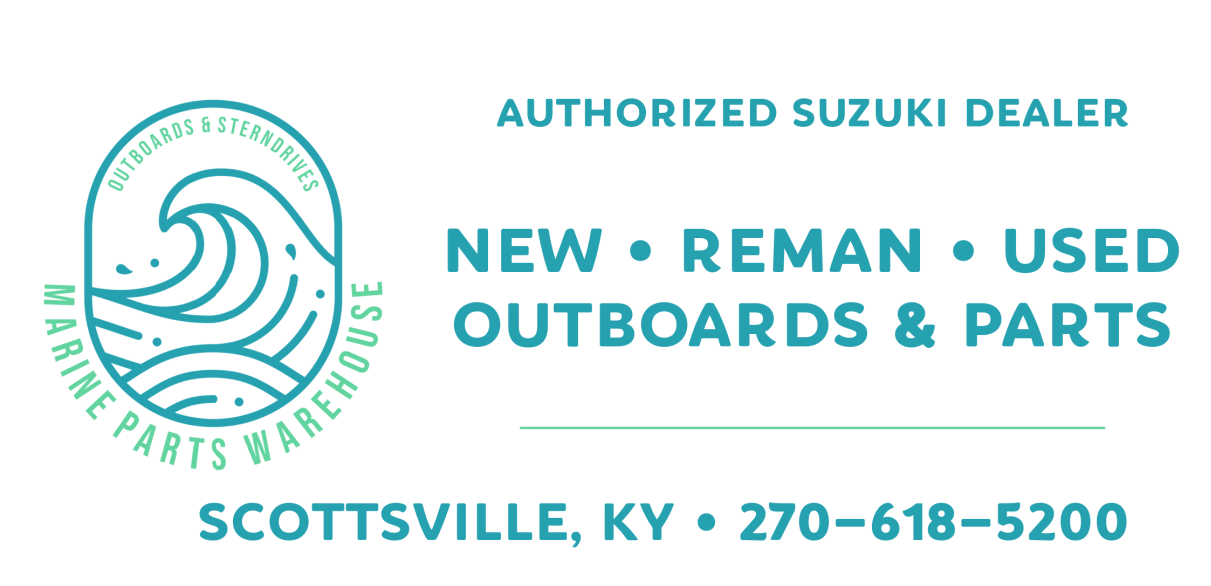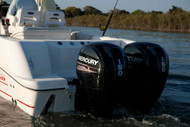The Pros & Cons of Twin Outboards
Take a stroll down the docks at any modern boat show, and you’ll likely see boats with multiple high-horsepower outboard motors stuffed across the transom.
Today, it’s not uncommon to see four, five, or even six outboards delivering thousands of horsepower on large offshore center consoles that can be 60 feet or more in length.

Here’s a look at some of the differences between single and twin outboard boats, as well as some of the advantages and disadvantages of having two motors.
Are two outboards better than one? The short answer is that it depends.
Not all boats can be set up to take twin outboards. Catamarans nearly always require twins, but smaller bay boats almost always are set up for a single outboard. Without custom work to the transom, two outboards just won’t fit.
The most common boats that might need to pick between one or two outboard motors are offshore deep vee-shaped fishing boats, usually in the mid-twenty foot range.
Boaters with boats in this foot range and up may face the very realistic choice of deciding on rigging it with one or two outboards.
This applies whether you’re repowering an existing boat or ordering a new one. The options have been expanded even further with the proliferation of larger, higher horsepower outboard choices.
With a variety of outboard motors now available in 300 to 600 horsepower, even larger boats can make do with a single motor where previously a minimum of two were required to provide enough power.
For example, an owner repowering a 28-foot pilothouse fishing boat could go with twin 175 hp motors, or a single 350.
The amount of horsepower on the transom is the same, but there will be some notable differences in cost, performance, fuel economy, maintenance, and more.
Neither is necessarily right or wrong - it depends on how you use your boat and what is important to you.

Single Engine Advantages:
1. Cost-Effective: Obviously, a single outboard motor is generally less expensive than multiple motors. The initial purchase cost, as well as annual maintenance and repair expenses, are lower. Outboard engines are simply much more reliable than they were 30 years ago. For an owner who boats close to boat towing services, the cost of an annual membership is far less than the cost of a second engine.
2. Simplicity: Managing a single motor is straightforward. There are fewer controls to handle, and it simplifies the rigging and maintenance routines.
3. Fuel Efficiency: Modern single outboard motors are designed to be highly fuel-efficient, and today most above 100-hp have fuel injection, and electronic control systems are available for most. Typically, a single engine will get better fuel economy, but is not always the case.
4. Weight: A single motor reduces the overall weight of the boat. A single large engine will almost always weigh less than two smaller engines.
Single Engine Disadvantages:
1. Possible Performance Limitations
A single motor will limit the boat's top speed and overall performance, particularly in larger, heavier boats. A single motor may not provide sufficient power for certain activities, such as towing skiers or navigating through rough waters.
A boat with a single engine may also labor to get on plane, particularly with a heavy load.
And, while higher horsepower engines might seem to be a good solution, remember all that added horsepower is being transferred to one propeller, which is not much bigger than the ones on lower horsepower engines.
To put this to the test, we looked at Yamaha’s performance bulletins for the Key West 244CC, which was tested with a wide range of power configurations, including a single F250 and twin F115s.

The single F250 achieved a top speed of 45.2 mph versus 43 mph for a pair of F115s, owing to the extra weight of the twins, as well as to their slightly lower overall horsepower.
In comparing the performance of the same boat model powered by a single Yamaha F300 against a pair of Yamaha F150s, the twins posted the better speed of 53.6 mph versus 49.5 mph for the single.
While a single should be faster, factors such as propping and engine height can affect the top speed of either setup.
2. Running Solo: If the single motor fails, the boat is left without propulsion. This poses a significant risk in remote areas or during extended outings – far from towing services.
3. Maneuverability and Docking: A single-engine powered boat faces challenges when docking, particularly in strong winds or a cross current. Techniques must be learned to dock safely – but remember, people have been successfully docking with a single engine for over 100 years.
However, a bow thruster can be installed in the aftermarket, or installed new, which makes docking much easier and may be preferable to a twin-engine installation.
In any case, it is less expensive than a second engine, with the added savings of (usually) no annual maintenance.
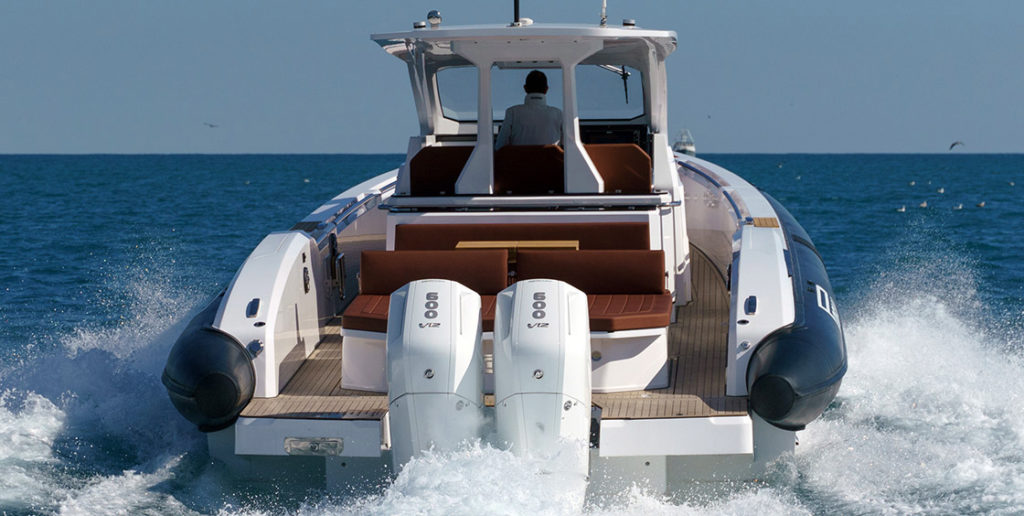
Advantages to Multiple Outboards
There are several reasons that people choose to rig two outboards instead of one. Some huge boats may require more horsepower than one engine alone can make.
1. Increased Power: Two motors can provide greater total horsepower, which enhances speed, acceleration, and the ability to handle heavier loads or rougher conditions, and get on plane faster.
Instead of twin 150s, for example, many buyers opt for twin four-cylinder 200s. There is little or no extra weight for this upgrade, yet it gives the boat an additional 100 hp that should result in a big top-speed advantage over the single 300.
2. Redundancy and Reliability: The number one argument for having two motors is that you have a backup if one fails. But what are the chances that one will fail? The truth is, today’s outboards are more reliable than ever before, but with two motors, if one fails, the other engine can still provide get-home propulsion.
Consider this, if you have two outboards, then your chances for failure double. This line of thinking is well known to professional aircraft pilots. When learning to fly multi-engine airplanes, many believe that they are safe from having an engine failure. What they learn in training, however, is that they are now exactly twice as likely to suffer an engine failure.
Depending on where you boat and what you like to do, if one engines goes down, and you have to wait a month – or longer – for the local dealer to get around to fixing it, you can still go boating at displacement speeds.
3. Better Maneuverability: Dual outboards improve maneuverability and control, especially at low speeds and in tight spaces and cross-currents. A twin-engine boat has the upper hand when maneuvering in tight marinas.
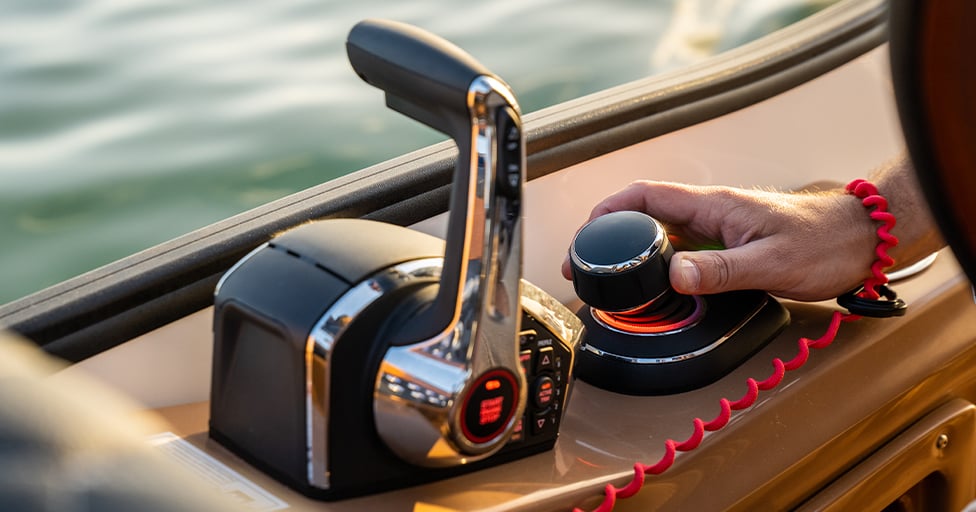
The skipper can use differential thrust to turn the boat tightly, usually within its length. The newest fly-by-wire motors and steering systems are computerized, allowing for amazingly easy docking with simple joystick control.
4. Enhanced Stability: The distribution of weight between two motors can improve the boat’s balance and stability, making it more comfortable to operate.
5. Possible Increased Fuel Economy: While it might seem counterintuitive, we have found over and over again in our testing that two engines often burn less fuel at cruising speeds than one higher horsepower engine.
The reason for this seems to be that outboard engine propellers are relatively small and it is difficult for them to transform horsepower to thrust for that reason. With two engines turning two props, those engines can lope along, while a single engine must work harder at a higher RPM to attain the same speed.
6. Increased Hole Shot: As with top speed, acceleration times can vary, but generally speaking, twin outboards should achieve a quicker hole shot than a single outboard of the same horsepower.
This is because twins have greater blade area with which to punch out of the hole, and drag is less of a factor during initial acceleration than at higher velocities.
With the Key West 244 cited above, the twin 115s vaulted to 30 mph in 5.57 seconds, while the single 250 took 8.97 seconds to reach the same speed. The twin 150s attained 30 mph in 5.42 seconds, and the single 300 took only slightly longer, 5.61 seconds.
Disadvantages of Multiple Outboards
Of course, it’s not all good news. Buying two outboards for your boat means, well, buying two outboards for your boat.
1. Increased Cost: The purchase cost, maintenance, and repair expenses are higher compared to a single motor setup.
The cost of purchasing two engines is rarely less than the cost of buying one big engine. In other words, bigger engines are more expensive than smaller ones, but they are seldom twice the price. From the start of your project, buying two motors is going to cost more. We suggest learning some DIY outboard maintenance.
2. Complexity: Operating and maintaining two outboard motors involves nearly twice as many things to go wrong. Having two engines instead of one means that there are twice as many parts and systems to go wrong – increasing your time waiting for your dealer to get around to fixing your engine – something that usually doesn’t happen fast in the summertime.
3. Space Consumption: Two outboards take up more space on the transom, which might limit space for other equipment or watersports activities.
4. Performance Improvement is Not Linear: Doubling your horsepower does not double your speed. In fact, depending on your boat and the engines, your top speed may only increase 5 to 9 mph. So, if you’re getting a twin-engine rig to out gun your buddies, you will pay dearly for that extra improvement in performance.
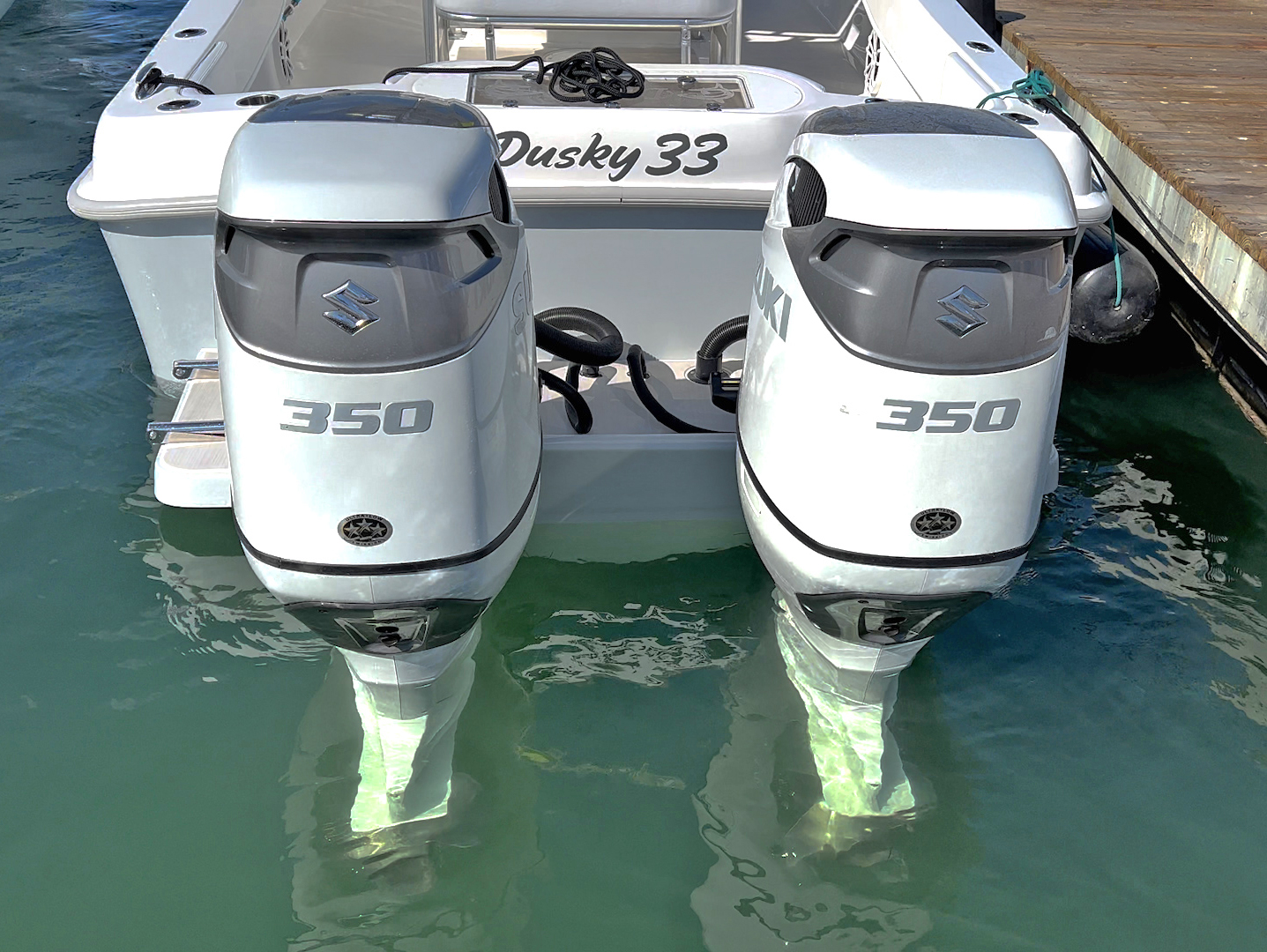
5. Weight: Most 300 horsepower engines are V-6 models, whereas the 150s are inline four cylinders. The weight of two outboards is double, whereas a larger V-6 is going to make most of its power for very little additional weight over one I-4.
Having less weight on the transom will mean that the boat will perform and balance better. It might also be an essential consideration if you are repowering an older boat that came with two-stroke engines. Two-stroke motors were much lighter than modern four-strokes, so weight is a significant factor when repowering.
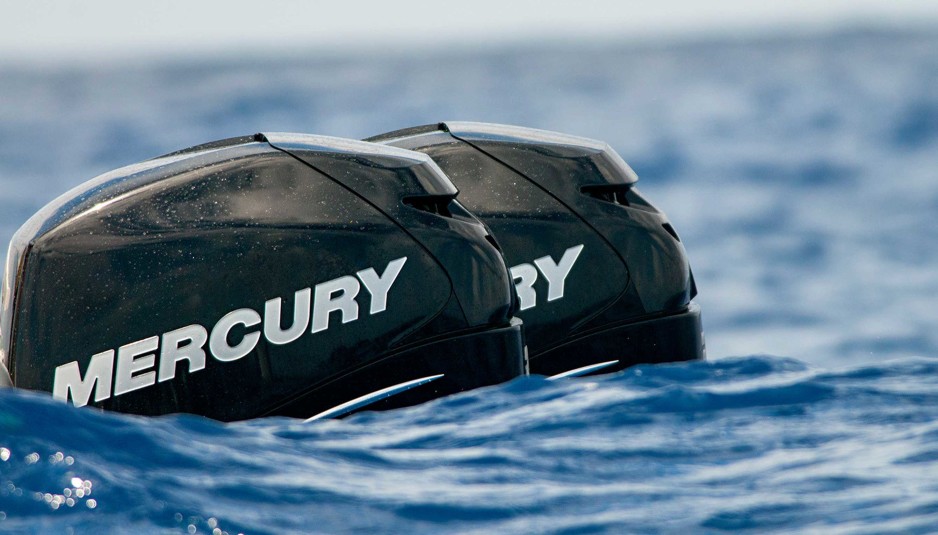
6. Fuel Related Issues: The most common problems that affect outboard motors today are fuel related. Water contamination or low-quality ethanol fuels are common culprits. Unless your boat has two completely independent fuel systems with two separate tanks, any fuel issue is likely to affect both of your engines at the same time. And even if you do have two tanks, it’s possible that the problem would affect them both.
Conclusion
Boats up to about 30’ are usually able to perform well with a single engine, if it has enough horsepower and is propped correctly. If you are a speed-freak, or you will be carrying a heavy load most of the time, or running out to the canyons every weekend, then consider twins for longevity, better fuel economy and redundancy.
You will pay more for a twin-engine rig both at the time of purchase and with annual maintenance, but most of the time the boat will also be worth more at resale time, and the audience of people interested in your boat may be larger as well.
Posted by Derek Zoolander
